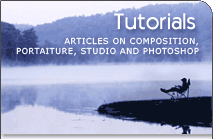This article belongs completely to Ed Shapiro, a professional photographer, who contributed a lot to the art. It is based on the content of a topic of forum. I have to thank Ed for covering this topic. I could not find any place where Ed gathered and published his knowledge, so I decided to extend the audience of the forum where he posted this topic. So here it goes...
Gobos and Flags
These are used to block or subtract light unlike reflectors and modifiers that spread or add light. “Gobo” comes from the old cinematographer's term - short for go-between. Experienced portraitists call them head-screens in that they use them to selectively shade areas like bald heads. They can be used like barn doors but they are more mobile. They are also good for blocking stray light from hitting the lens when working out of doors or when working with kicker lights at very acute angles where a lens shade may fail in certain extreme conditions. Black in colour, these items come in various incarnations and sizes - flag shaped, discs, flats, and flat umbrella style. Oftentimes a simple piece of black cardboard will do the trick. Gobos can be mounted on light stands, goose-neck stands or held for short periods of time by an assistant. The effect is more pronounced with parabolic lights than with defused lighting. Check you exposure meter when using gobos to see if any exposure is lost.
Some photographers never leave their gobos at home when they are making outdoor portraits. The subject is placed in open shade and 2 gobos- configured in an upside-down “L” shape are used to block the light from one side and above. The light allowed in is more like window light which will lend more modeling to the face and avoid shadows in the eye sockets which so often spoil outdoor portraits. That method is called subtractive lighting.
~ Top ~Grids
These are honeycomb-like grids that act as SUPER - barndoors. Spotlight effects can be obtained from regular parabolic lighting units by simply placing a grid of the proper diameter, over the light source. They are handy for kickers and hair lights. When doing commercial shots with front or rear projection, they are very useful in that they help keep the light off of the background. There are also grids that look like vertical blinds. The numbers assigned to the grids refer to size of the openings in the honeycomb pattern. Feathering the lights does NOT work well with grids because the periphery of the beam becomes compressed in order to form a more concentrated beam of light. As with gobos- make reading to check for light loss and to determine the rate of fall off.
These are all fun tools to work with but they are not all necessary for good lighting. A simple set of parabolic lights, with feathering and proper “barn-dooring” can create all kinds of beautiful textures in the skin tones of the subjects.
~ Top ~Gobos and flags.
All theses units should be made of black opaque materials that do not transmit or reflect any light. If they are painted flat black or covered with black felt or velvet - all the better. Their job is to absorb light and create shade or shadow - they are light BLOCKERS.
When placed between a light source and the subject, they are supposed to cast shadows in a subtle way. When kept close to the light source the shadows will be less delineated but will become more apparent as the blocker is moved closer to the subject. Depending on these distances, the type of lighting unit used and the orientation of the blocker, there are many effects possible. As with all fine lighting usage, the all over effect should be as natural as possible - not calling attention to the methods and tools used.
The reason I suggested making readings with the aesthetic controls in place, is that scrims, gobos, vignetters and other such devices can introduce a loss in the volume of illumination. Meter checks insure that your negative density and lighting ratios are preserved after adding light control and modifying devices to the equation. ![End of the article [end of the text]](http://www.romanzolin.com/img/misc/text_end_ed.png)





